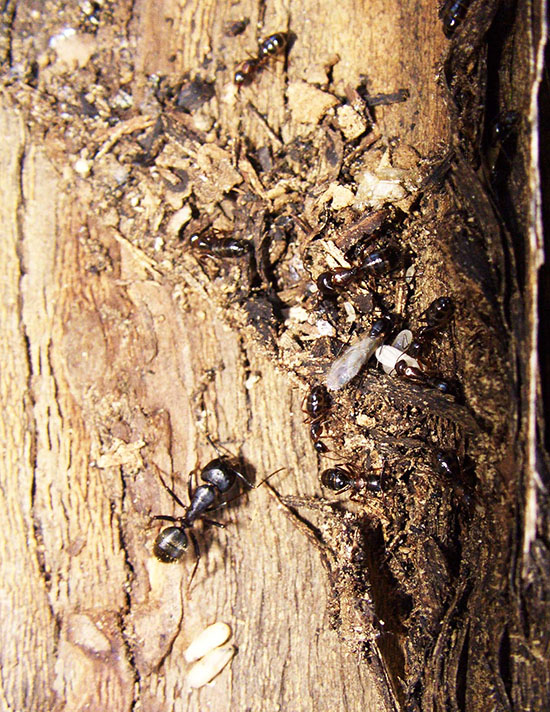Issue 16, September 20, 2016
Carpenter Ants in Trees
Carpenter ants normally do not need to be controlled in trees because they usually cause little or no damage to the tree. They are very numerous. I commonly say that if you stare at the trunk of an older tree for at least 30 seconds during the growing season and don't see a carpenter ant climbing up or down, you probably have your eyes shut.
Carpenter ants vary in size and color. The black carpenter ant is probably the most noticed species in landscapes. Worker ants are non-reproducing females that are wingless and black. Workers come in two size ranges. Minor workers are approximately 1/4 inch long and do much of the food foraging, nest construction, and larval feeding; they also attend the queen. Major workers are also wingless and black, but are about 1/2 inch long and play a major role in defending the nest and minor workers.

Carpenter ant nest opening in tree.
The black carpenter ant is the only carpenter ant in Illinois that commonly locates its nests in buildings. They tunnel out wood that is damp or decaying from roof or water-pipe leaks. Main nests in trees also establish satellite colonies in nearby buildings.
The red carpenter ant is another common species, with red, wingless workers that are about 1/4 inch long. They are commonly seen on flower blossoms. Other, smaller species of carpenter ants are also common in Illinois.
Carpenter ants build their nests by hollowing out rotting wood; they do not eat the wood. Workers take mouthful-sized chips of wood to the nest entrance, where they deposit the chips. This results in a pile of coarse sawdust at the base of a tree. The nest itself consists of meandering, 1/4-inch-diameter tunnels that are free of sawdust. Egg laying, larval rearing, and pupation take place within these tunnels. Nests may be present in rotting wood in trunks, limbs, or roots. They do not nest in sound wood.

Carpenter ant nest, workers, and winged pupae in tree.
Nests that are at least five years old will contain winged reproductives. Black carpenter ant males are 1/4 inch long and have two pairs of clear wings. The queens are approximately 3/4 inch long and also have two pairs of clear wings. Both sexes emerge from the colony in early morning and fly towards the light to escape the colony. Mating occurs, and the reproductives break their wings off at abscission sites near the wing bases. Then they tunnel into damp, rotting wood to start a new colony.
Carpenter ant nests in trees are an indication of rotting wood. Such trees should be checked to determine whether the rot has weakened the tree enough that it becomes a hazard. Nests in trees close to a house may result in ants entering the house to forage. This nuisance can be eliminated by spraying a labeled pyrethroid insecticide such as permethrin or cyfluthrin into the nest or by pruning overhanging limbs at least three feet back from the roof. Otherwise, carpenter ant nests do not directly weaken the tree and do not usually require control. (Phil Nixon)
Author:
Phil Nixon